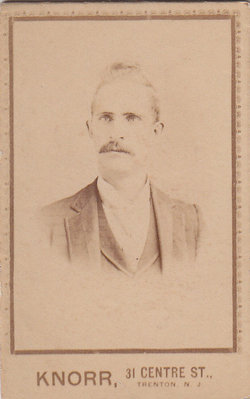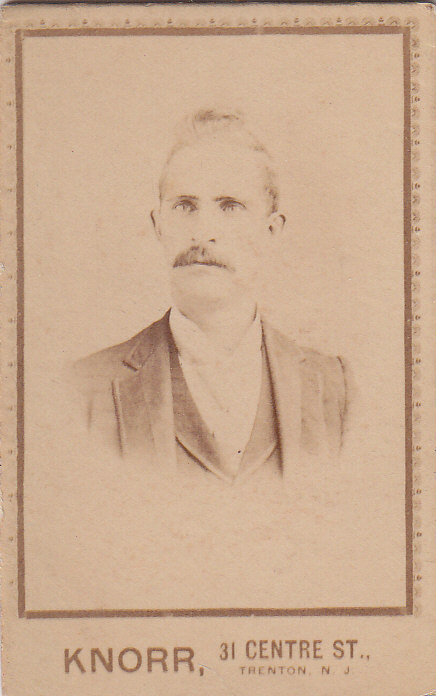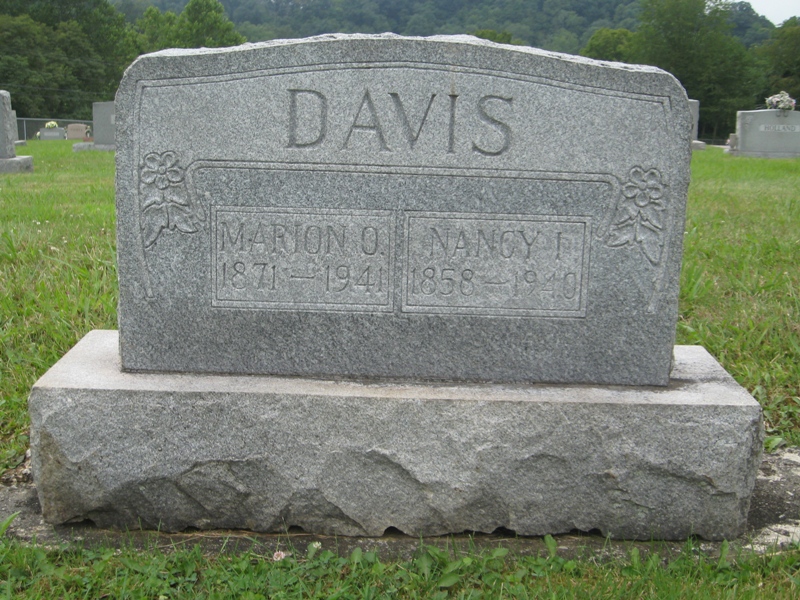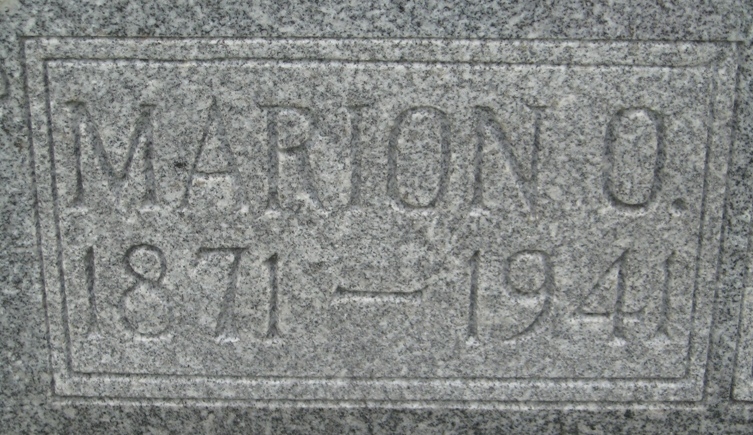Marion, also known as M.O., was born at Camp Mistake, Doddridge County, WV. When Marion was a young boy, he attended a one-room country school at Camp Mistake. This
old building has since been torn down and reconstructed at the Doddridge County Recreational Park, outside of Smithburg, WV. One of his teachers was Nancy lsabelle Weekley Dawson.
Nancy was 12 years his senior, and had been married to a man named Dawson. Her husband died at a very young age. ln 1895, when Marion was 24 years old, he married his former teacher, Nancy Weekley. According to records, the marriage of an earlier Davis woman into the Weekley Family, made Marion and Nancy second cousins. This was not uncommon during this era; due to isolated rural living and limited choices of mates.
Marion and Nancy had three children. The l900 census lists Marion, age 29, and Nancy, age 40, living in Doddridge County. They lived on a farm that adjoined his fathers' land at Camp Mistake, Grant District. His children, Earl was 5 years old, Lyndell age 3, and Elsie was 1 year old.
According to an account written about Nutters Fork and vacinity, Marion O. Davis was one of the first men to own a car in Grant District of Doddridge County. M.O., his father, and his son would drive from Camp Mistake to Marietta, Ohio. They would have probably taken Route 18 to Sistersville, crossed on the ferry, and drove down Route 7 on the Ohio side of the river. These trips were made once a year, to buy whiskey, because it was cheaper in Ohio. Also, many counties in WV were dry at that time. These excursions were made in a Model T Ford, and would have taken most of a day for the round trip. This was during the early 1900s.
During World War I, when Marion was in his fourties, he was out in the field shucking corn. Suddenly, he heard a strange noise. Looking up into the sky, he saw an airplane coming over the top of a hill. Now, Marion had never seen an airplane before, and it was very uncommon for a flying-machine to be coming over this area of the country. He ran and hid in a fodder shack until the plane had flown on and over the top of the next next hill. He was probably afraid that they were going to drop a bomb on his head. Rural people were not so up-to-date on the news during this period of time in our history.
ln 1923, Marion sold the farm at Camp Mistake and moved his family to West Union. He, and some other men, built a house in the Wabash addition of the town. At that time, Wabash was not in the corporation limits, and was much like living in a rural area; no electricity, water, or sewage.
The house that Marion helped to build, sat on the corner of Homestead Street and Cass Avenue. lt was a one-story frame house, with porches that ran along three sides of the structure. Marion always said that he built the porches, so he would have a place to run if his wife chased him. This way, he could run out the front door, around the porch, and into the back door, without getting wet in a rainstorm!
A cellar and cellar house sat beside the dwelling. A long, sloping yard stretched from the porch side down to an alley. Most of this big yard was utilized as gardens during the 1920s and 1930s.
During the 1930s, when he was in his early 60s, he was about 5 feet l0 l/2 inches tall and weighed over 200 pounds. One of his grandsons remembers him raising large gardens, tinkering in his garage workshop, and whittling things out of wood. His grandson was told, in later years, that Marion liked his liquor and frequently imbibed in this practice.
During the 1930s, Marion was constantly busy working his gardens during the summer months, or helping some of his friends work their fields. Winter months were spent loafing at the local blacksmith shop, on Homestead Street, and talking to his elderly friends.
Marion helped work on the roads around Doddridge County, when he was younger. He had been a foreman on the job when they rebuilt Route 18, north of West Union. He was handy with his hands, and could make most anything that he desired. Marion and Nancy continued to live at the house on Homestead Street through the 1930s and into the 1940s.
M.O. died of a heart attack.
Marion, also known as M.O., was born at Camp Mistake, Doddridge County, WV. When Marion was a young boy, he attended a one-room country school at Camp Mistake. This
old building has since been torn down and reconstructed at the Doddridge County Recreational Park, outside of Smithburg, WV. One of his teachers was Nancy lsabelle Weekley Dawson.
Nancy was 12 years his senior, and had been married to a man named Dawson. Her husband died at a very young age. ln 1895, when Marion was 24 years old, he married his former teacher, Nancy Weekley. According to records, the marriage of an earlier Davis woman into the Weekley Family, made Marion and Nancy second cousins. This was not uncommon during this era; due to isolated rural living and limited choices of mates.
Marion and Nancy had three children. The l900 census lists Marion, age 29, and Nancy, age 40, living in Doddridge County. They lived on a farm that adjoined his fathers' land at Camp Mistake, Grant District. His children, Earl was 5 years old, Lyndell age 3, and Elsie was 1 year old.
According to an account written about Nutters Fork and vacinity, Marion O. Davis was one of the first men to own a car in Grant District of Doddridge County. M.O., his father, and his son would drive from Camp Mistake to Marietta, Ohio. They would have probably taken Route 18 to Sistersville, crossed on the ferry, and drove down Route 7 on the Ohio side of the river. These trips were made once a year, to buy whiskey, because it was cheaper in Ohio. Also, many counties in WV were dry at that time. These excursions were made in a Model T Ford, and would have taken most of a day for the round trip. This was during the early 1900s.
During World War I, when Marion was in his fourties, he was out in the field shucking corn. Suddenly, he heard a strange noise. Looking up into the sky, he saw an airplane coming over the top of a hill. Now, Marion had never seen an airplane before, and it was very uncommon for a flying-machine to be coming over this area of the country. He ran and hid in a fodder shack until the plane had flown on and over the top of the next next hill. He was probably afraid that they were going to drop a bomb on his head. Rural people were not so up-to-date on the news during this period of time in our history.
ln 1923, Marion sold the farm at Camp Mistake and moved his family to West Union. He, and some other men, built a house in the Wabash addition of the town. At that time, Wabash was not in the corporation limits, and was much like living in a rural area; no electricity, water, or sewage.
The house that Marion helped to build, sat on the corner of Homestead Street and Cass Avenue. lt was a one-story frame house, with porches that ran along three sides of the structure. Marion always said that he built the porches, so he would have a place to run if his wife chased him. This way, he could run out the front door, around the porch, and into the back door, without getting wet in a rainstorm!
A cellar and cellar house sat beside the dwelling. A long, sloping yard stretched from the porch side down to an alley. Most of this big yard was utilized as gardens during the 1920s and 1930s.
During the 1930s, when he was in his early 60s, he was about 5 feet l0 l/2 inches tall and weighed over 200 pounds. One of his grandsons remembers him raising large gardens, tinkering in his garage workshop, and whittling things out of wood. His grandson was told, in later years, that Marion liked his liquor and frequently imbibed in this practice.
During the 1930s, Marion was constantly busy working his gardens during the summer months, or helping some of his friends work their fields. Winter months were spent loafing at the local blacksmith shop, on Homestead Street, and talking to his elderly friends.
Marion helped work on the roads around Doddridge County, when he was younger. He had been a foreman on the job when they rebuilt Route 18, north of West Union. He was handy with his hands, and could make most anything that he desired. Marion and Nancy continued to live at the house on Homestead Street through the 1930s and into the 1940s.
M.O. died of a heart attack.
Family Members
Sponsored by Ancestry
Advertisement
Advertisement

















